Paper Menu >>
Journal Menu >>
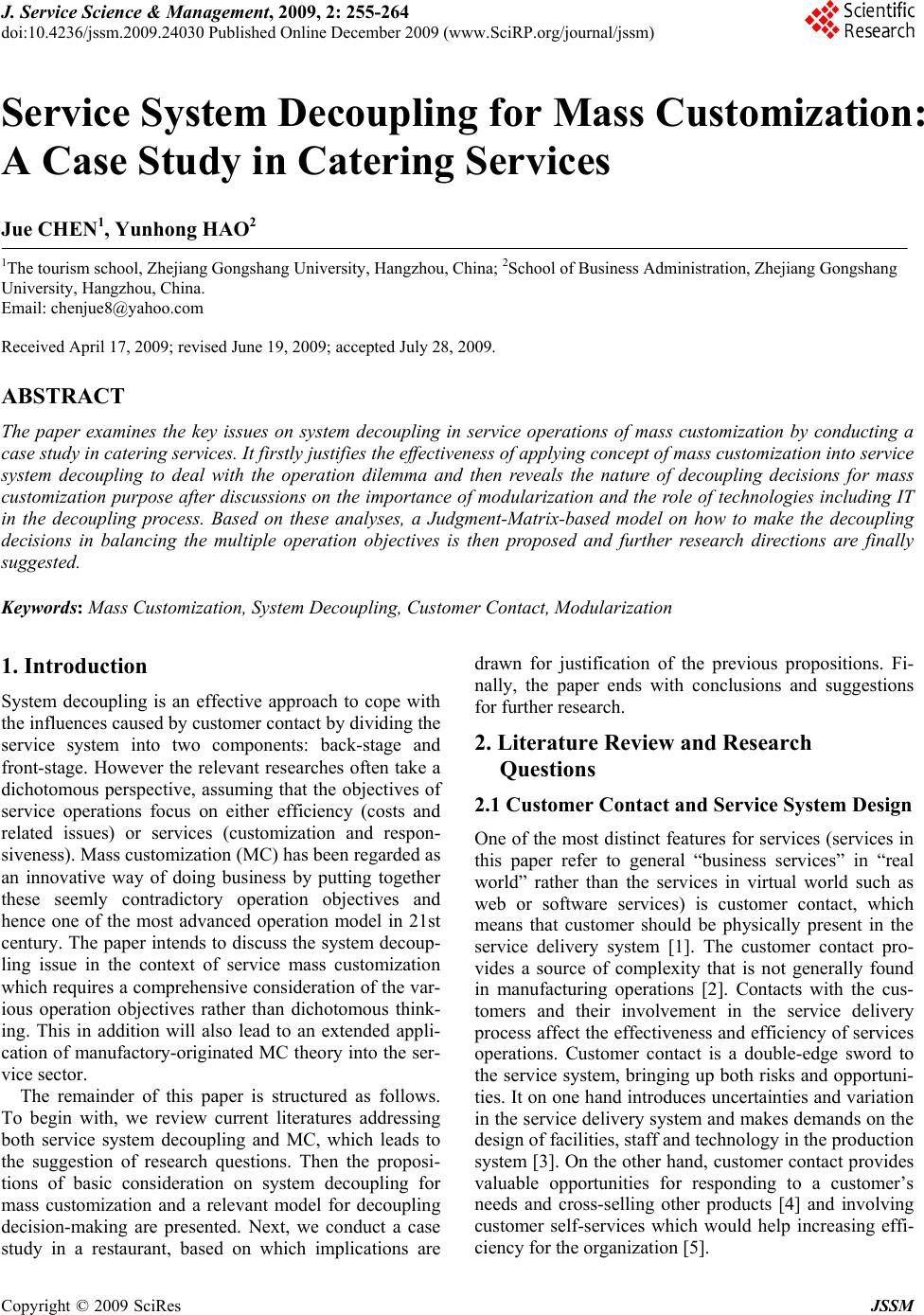 J. Service Science & Management, 2009, 2: 255-264 doi:10.4236/jssm.2009.24030 Published Online December 2009 (www.SciRP.org/journal/jssm) Copyright © 2009 SciRes JSSM 255 Service System Decoupling for Mass Customization: A Case Study in Catering Services Jue CHEN1, Yunhong HAO2 1The tourism school, Zhejiang Gongshang University, Hangzhou, China; 2School of Business Administration, Zhejiang Gongshang University, Hangzhou, China. Email: chenjue8@yahoo.com Received April 17, 2009; revised June 19, 2009; accepted July 28, 2009. ABSTRACT The paper examines the key issues on system decoupling in service operations of mass customization by conducting a case study in catering services. It firstly justifies the effectiveness of applying concept of mass custom izatio n into service system decoupling to deal with the operation dilemma and then reveals the nature of decoupling decisions for mass customization purpose after discussions on the importance of modularization and the role of technologies including IT in the decoupling process. Based on these analyses, a Judgment-Matrix-based model on how to make the decoupling decisions in balancing the multiple operation objectives is then proposed and further research directions are finally suggested. Keywords: Mass Customization, System Decoupling, Customer Contact, Modularization 1. Introduction System decoupling is an effective approach to cope with the influences caused by customer contact by dividing the service system into two components: back-stage and front-stage. However the relevant researches often take a dichotomous perspective, assuming that the objectives of service operations focus on either efficiency (costs and related issues) or services (customization and respon- siveness). Mass customization (MC) has been regarded as an innovative way of doing business by putting together these seemly contradictory operation objectives and hence one of the most advanced operation model in 21st century. The paper intends to discuss the system decoup- ling issue in the context of service mass customization which requires a comprehensive consideration of the var- ious operation objectives rather than dichotomous think- ing. This in addition will also lead to an extended appli- cation of manufactory-originated MC theory into the ser- vice sector. The remainder of this paper is structured as follows. To begin with, we review current literatures addressing both service system decoupling and MC, which leads to the suggestion of research questions. Then the proposi- tions of basic consideration on system decoupling for mass customization and a relevant model for decoupling decision-making are presented. Next, we conduct a case study in a restaurant, based on which implications are drawn for justification of the previous propositions. Fi- nally, the paper ends with conclusions and suggestions for further research. 2. Literature Review and Research Questions 2.1 Customer Contact and Service System Design One of the most distinct features for services (services in this paper refer to general “business services” in “real world” rather than the services in virtual world such as web or software services) is customer contact, which means that customer should be physically present in the service delivery system [1]. The customer contact pro- vides a source of complexity that is not generally found in manufacturing operations [2]. Contacts with the cus- tomers and their involvement in the service delivery process affect the effectiveness and efficiency of services operations. Customer contact is a double-edge sword to the service system, bringing up both risks and opportuni- ties. It on one hand introduces uncertainties and variation in the service delivery system and makes demands on the design of facilities, staff and technology in the production system [3]. On the other hand, customer contact provides valuable opportunities for responding to a customer’s needs and cross-selling other products [4] and involving customer self-services which would help increasing effi- ciency for the organization [5]. 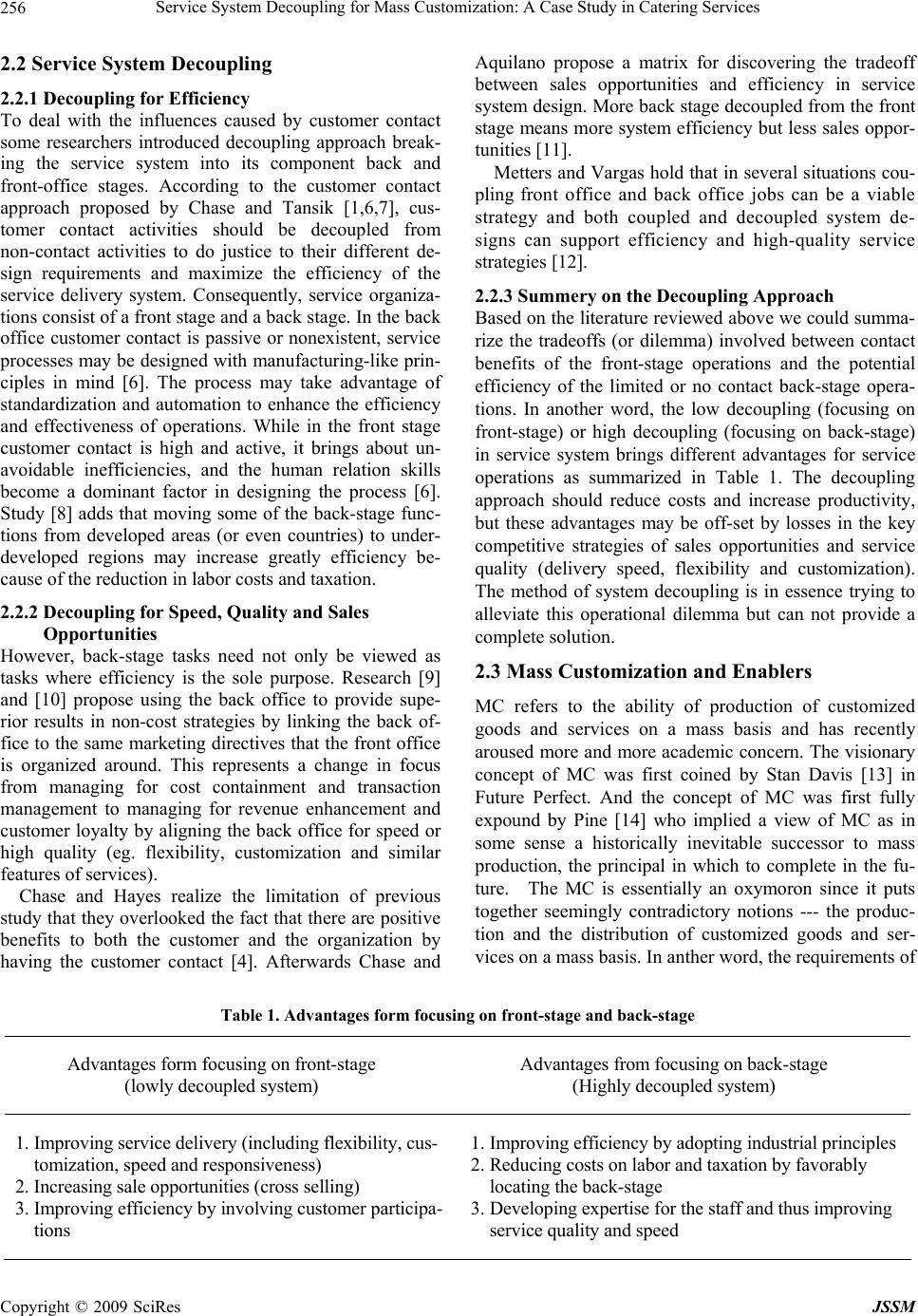 Service System Decoupling for Mass Customization: A Case Study in Catering Services 256 2.2 Service System Decoupling 2.2.1 Decoupling for Efficiency To deal with the influences caused by customer contact some researchers introduced decoupling approach break- ing the service system into its component back and front-office stages. According to the customer contact approach proposed by Chase and Tansik [1,6,7], cus- tomer contact activities should be decoupled from non-contact activities to do justice to their different de- sign requirements and maximize the efficiency of the service delivery system. Consequently, service organiza- tions consist of a front stage and a back stage. In the back office customer contact is passive or nonexistent, service processes may be designed with manufacturing-like prin- ciples in mind [6]. The process may take advantage of standardization and automation to enhance the efficiency and effectiveness of operations. While in the front stage customer contact is high and active, it brings about un- avoidable inefficiencies, and the human relation skills become a dominant factor in designing the process [6]. Study [8] adds that moving some of the back-stage func- tions from developed areas (or even countries) to under- developed regions may increase greatly efficiency be- cause of the reduction in labor costs and taxation. 2.2.2 Dec oupling for Speed, Q ua lity an d S ales Opportunities However, back-stage tasks need not only be viewed as tasks where efficiency is the sole purpose. Research [9] and [10] propose using the back office to provide supe- rior results in non-cost strategies by linking the back of- fice to the same marketing directives that the front office is organized around. This represents a change in focus from managing for cost containment and transaction management to managing for revenue enhancement and customer loyalty by aligning the back office for speed or high quality (eg. flexibility, customization and similar features of services). Chase and Hayes realize the limitation of previous study that they overlooked the fact that there are positive benefits to both the customer and the organization by having the customer contact [4]. Afterwards Chase and Aquilano propose a matrix for discovering the tradeoff between sales opportunities and efficiency in service system design. More back stage decoupled from the front stage means more system efficiency but less sales oppor- tunities [11]. Metters and Vargas hold that in several situations cou- pling front office and back office jobs can be a viable strategy and both coupled and decoupled system de- signs can support efficiency and high-quality service strategies [12]. 2.2.3 Summery on the Decoupling Approach Based on the literature reviewed above we could summa- rize the tradeoffs (or dilemma) involved between contact benefits of the front-stage operations and the potential efficiency of the limited or no contact back-stage opera- tions. In another word, the low decoupling (focusing on front-stage) or high decoupling (focusing on back-stage) in service system brings different advantages for service operations as summarized in Table 1. The decoupling approach should reduce costs and increase productivity, but these advantages may be off-set by losses in the key competitive strategies of sales opportunities and service quality (delivery speed, flexibility and customization). The method of system decoupling is in essence trying to alleviate this operational dilemma but can not provide a complete solution. 2.3 Mass Customization and Enablers MC refers to the ability of production of customized goods and services on a mass basis and has recently aroused more and more academic concern. The visionary concept of MC was first coined by Stan Davis [13] in Future Perfect. And the concept of MC was first fully expound by Pine [14] who implied a view of MC as in some sense a historically inevitable successor to mass production, the principal in which to complete in the fu- ture. The MC is essentially an oxymoron since it puts together seemingly contradictory notions --- the produc- tion and the distribution of customized goods and ser- vices on a mass basis. In anther word, the requirements of Table 1. Advantages form focusing on front-stage and back-stage Advantages form focusing on front-stage (lowly decoupled system) Advantages from focusing on back-stage (Highly decoupled system) 1. Improving service delivery (including flexibility, cus- tomization, speed and responsiveness) 2. Increasing sale opportunities (cross selling) 3. Improving efficiency by involving customer participa- tions 1. Improving efficiency by adopting industrial principles 2. Reducing costs on labor and taxation by favorably locating the back-stage 3. Developing expertise for the staff and thus improving service quality and speed Copyright © 2009 SciRes JSSM 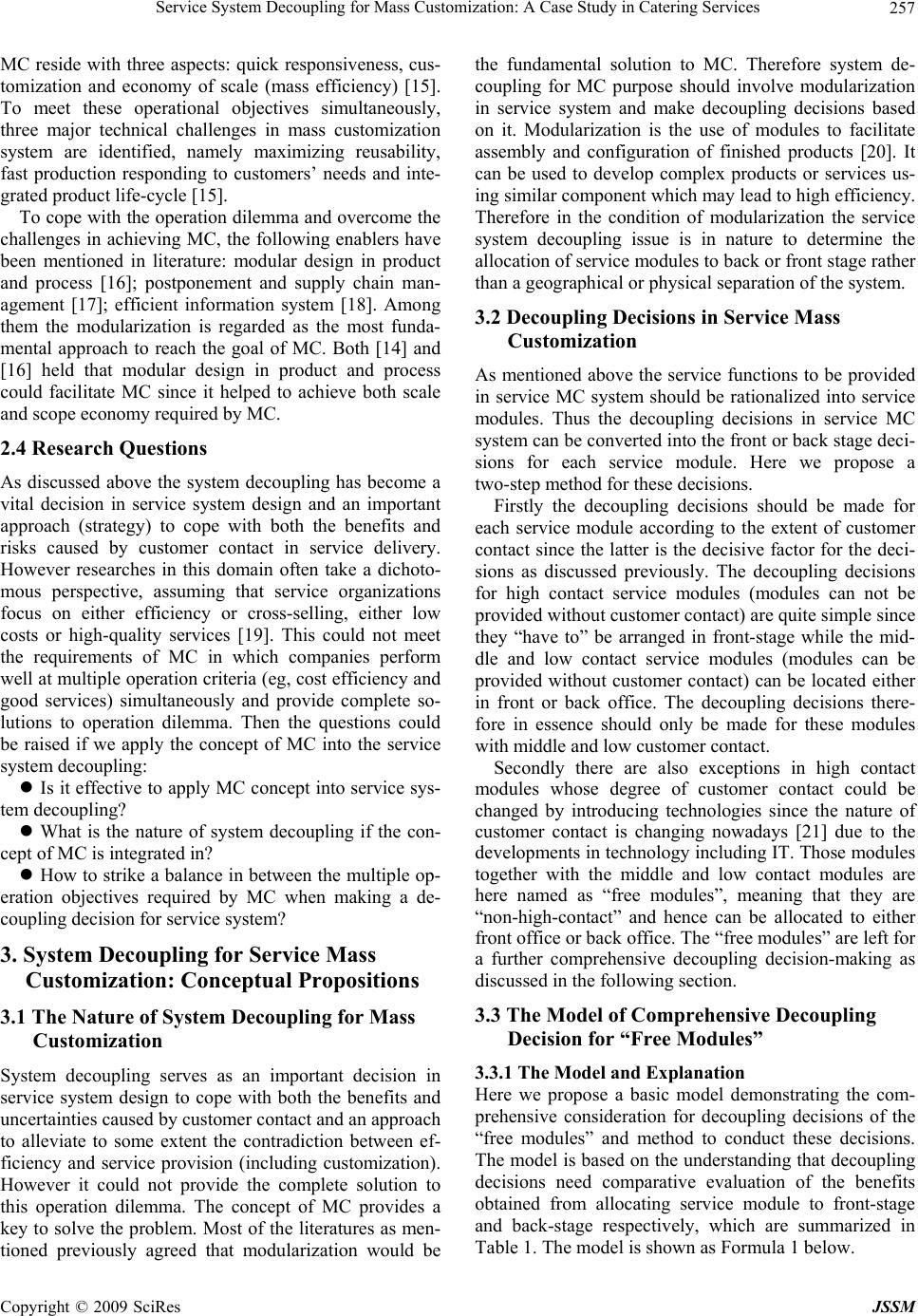 Service System Decoupling for Mass Customization: A Case Study in Catering Services257 MC reside with three aspects: quick responsiveness, cus- tomization and economy of scale (mass efficiency) [15]. To meet these operational objectives simultaneously, three major technical challenges in mass customization system are identified, namely maximizing reusability, fast production responding to customers’ needs and inte- grated product life-cycle [15]. To cope with the operation dilemma and overcome the challenges in achieving MC, the following enablers have been mentioned in literature: modular design in product and process [16]; postponement and supply chain man- agement [17]; efficient information system [18]. Among them the modularization is regarded as the most funda- mental approach to reach the goal of MC. Both [14] and [16] held that modular design in product and process could facilitate MC since it helped to achieve both scale and scope economy required by MC. 2.4 Research Questions As discussed above the system decoupling has become a vital decision in service system design and an important approach (strategy) to cope with both the benefits and risks caused by customer contact in service delivery. However researches in this domain often take a dichoto- mous perspective, assuming that service organizations focus on either efficiency or cross-selling, either low costs or high-quality services [19]. This could not meet the requirements of MC in which companies perform well at multiple operation criteria (eg, cost efficiency and good services) simultaneously and provide complete so- lutions to operation dilemma. Then the questions could be raised if we apply the concept of MC into the service system decoupling: Is it effective to apply MC concept into service sys- tem decoupling? What is the nature of system decoupling if the con- cept of MC is integrated in? How to strike a balance in between the multiple op- eration objectives required by MC when making a de- coupling decision for service system? 3. System Decoupling for Service Mass Customization: Conceptual Propositions 3.1 The Nature of System Decoupling for Mass Customization System decoupling serves as an important decision in service system design to cope with both the benefits and uncertainties caused by customer contact and an approach to alleviate to some extent the contradiction between ef- ficiency and service provision (including customization). However it could not provide the complete solution to this operation dilemma. The concept of MC provides a key to solve the problem. Most of the literatures as men- tioned previously agreed that modularization would be the fundamental solution to MC. Therefore system de- coupling for MC purpose should involve modularization in service system and make decoupling decisions based on it. Modularization is the use of modules to facilitate assembly and configuration of finished products [20]. It can be used to develop complex products or services us- ing similar component which may lead to high efficiency. Therefore in the condition of modularization the service system decoupling issue is in nature to determine the allocation of service modules to back or front stage rather than a geographical or physical separation of the system. 3.2 Decoupling Decisions in Service Mass Customization As mentioned above the service functions to be provided in service MC system should be rationalized into service modules. Thus the decoupling decisions in service MC system can be converted into the front or back stage deci- sions for each service module. Here we propose a two-step method for these decisions. Firstly the decoupling decisions should be made for each service module according to the extent of customer contact since the latter is the decisive factor for the deci- sions as discussed previously. The decoupling decisions for high contact service modules (modules can not be provided without customer contact) are quite simple since they “have to” be arranged in front-stage while the mid- dle and low contact service modules (modules can be provided without customer contact) can be located either in front or back office. The decoupling decisions there- fore in essence should only be made for these modules with middle and low customer contact. Secondly there are also exceptions in high contact modules whose degree of customer contact could be changed by introducing technologies since the nature of customer contact is changing nowadays [21] due to the developments in technology including IT. Those modules together with the middle and low contact modules are here named as “free modules”, meaning that they are “non-high-contact” and hence can be allocated to either front office or back office. The “free modules” are left for a further comprehensive decoupling decision-making as discussed in the following section. 3.3 The Model of Comprehensive Decoupling Decision for “Free Modules” 3.3.1 The Model and Explanation Here we propose a basic model demonstrating the com- prehensive consideration for decoupling decisions of the “free modules” and method to conduct these decisions. The model is based on the understanding that decoupling decisions need comparative evaluation of the benefits obtained from allocating service module to front-stage and back-stage respectively, which are summarized in Table 1. The model is shown as Formula 1 below. Copyright © 2009 SciRes JSSM 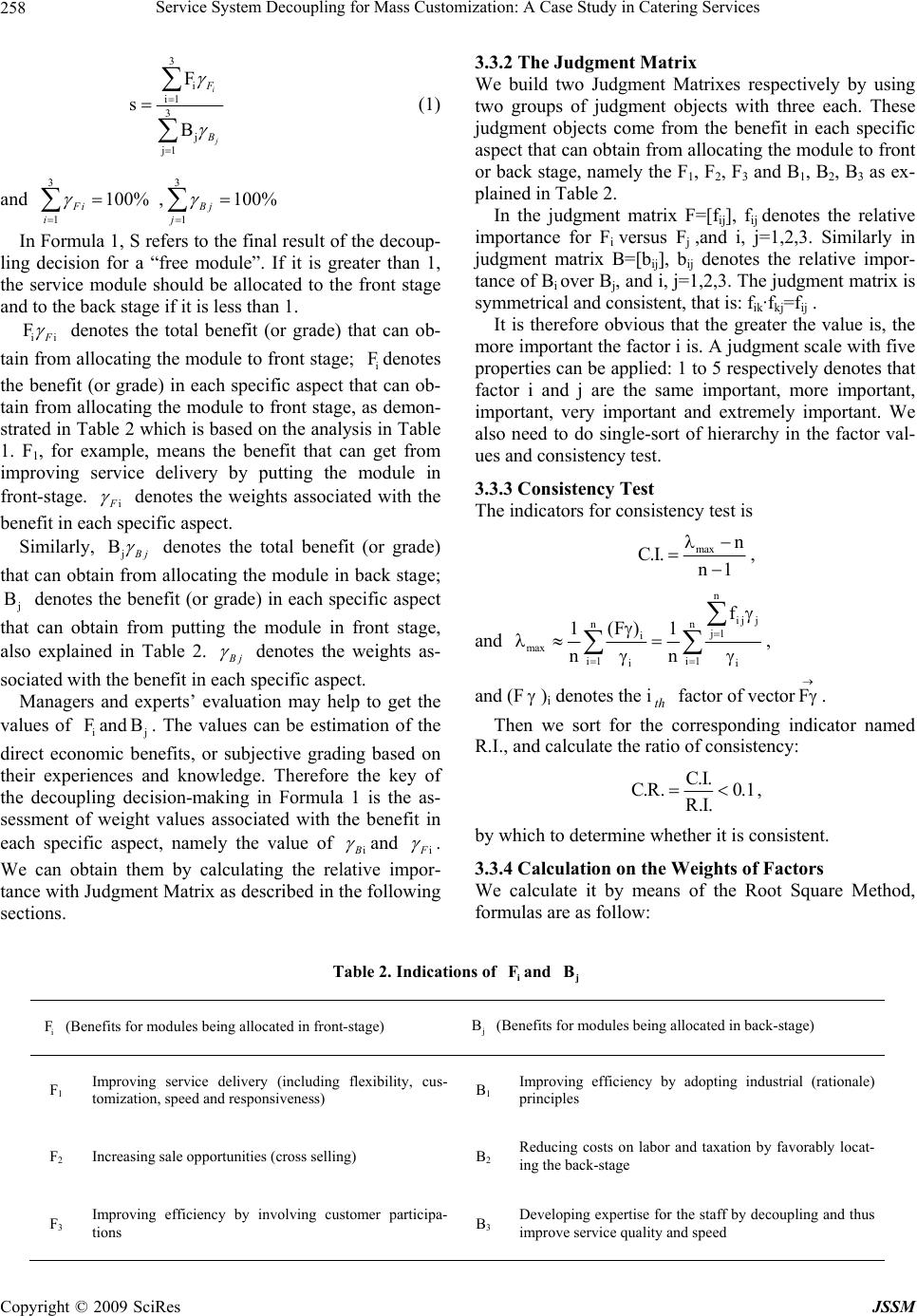 Service System Decoupling for Mass Customization: A Case Study in Catering Services 258 3 i i1 3 j j1 F s B i j F B (1) and , 3 1 100% Fi i 3 1 100% Bj j In Formula 1, S refers to the final result of the decoup- ling decision for a “free module”. If it is greater than 1, the service module should be allocated to the front stage and to the back stage if it is less than 1. ii F F denotes the total benefit (or grade) that can ob- tain from allocating the module to front stage; denotes the benefit (or grade) in each specific aspect that can ob- tain from allocating the module to front stage, as demon- strated in Table 2 which is based on the analysis in Table 1. F1, for example, means the benefit that can get from improving service delivery by putting the module in front-stage. i F i F denotes the weights associated with the benefit in each specific aspect. Similarly, j B B j denotes the total benefit (or grade) that can obtain from allocating the module in back stage; denotes the benefit (or grade) in each specific aspect that can obtain from putting the module in front stage, also explained in Table 2. j B B j denotes the weights as- sociated with the benefit in each specific aspect. Managers and experts’ evaluation may help to get the values of and . The values can be estimation of the direct economic benefits, or subjective grading based on their experiences and knowledge. Therefore the key of the decoupling decision-making in Formula 1 is the as- sessment of weight values associated with the benefit in each specific aspect, namely the value of i Fj B i B and i F . We can obtain them by calculating the relative impor- tance with Judgment Matrix as described in the following sections. 3.3.2 The Judgment Matrix We build two Judgment Matrixes respectively by using two groups of judgment objects with three each. These judgment objects come from the benefit in each specific aspect that can obtain from allocating the module to front or back stage, namely the F1, F2, F3 and B1, B2, B3 as ex- plained in Table 2. In the judgment matrix F=[fij], fij denotes the relative importance for Fi versus Fj ,and i, j=1,2,3. Similarly in judgment matrix B=[bij], bij denotes the relative impor- tance of Bi over Bj, and i, j=1,2,3. The judgment matrix is symmetrical and consistent, that is: fik·fkj=fij . It is therefore obvious that the greater the value is, the more important the factor i is. A judgment scale with five properties can be applied: 1 to 5 respectively denotes that factor i and j are the same important, more important, important, very important and extremely important. We also need to do single-sort of hierarchy in the factor val- ues and consistency test. 3.3.3 Co nsistency Test The indicators for consistency test is max n C.I. n1 , and n ij j nn j1 i max i1 i1 ii f (F ) 11 nn , and (F )i denotes the i factor of vector th F . Then we sort for the corresponding indicator named R.I., and calculate the ratio of consistency: C.I. C.R.0.1 R.I. , by which to determine whether it is consistent. 3.3.4 Cal c u lation o n the Weight s of F actors We calculate it by means of the Root Square Method, formulas are as follow: Table 2. Indications of and i F j B i F (Benefits for modules being allocated in front-stage) j B (Benefits for modules being allocated in back-stage) F1 Improving service delivery (including flexibility, cus- tomization, speed and responsiveness) B1 Improving efficiency by adopting industrial (rationale) principles F2 Increasing sale opportunities (cross selling) B2 Reducing costs on labor and taxation by favorably locat- ing the back-stage F3 Improving efficiency by involving customer participa- tions B3 Developing expertise for the staff by decoupling and thus improve service quality and speed Copyright © 2009 SciRes JSSM 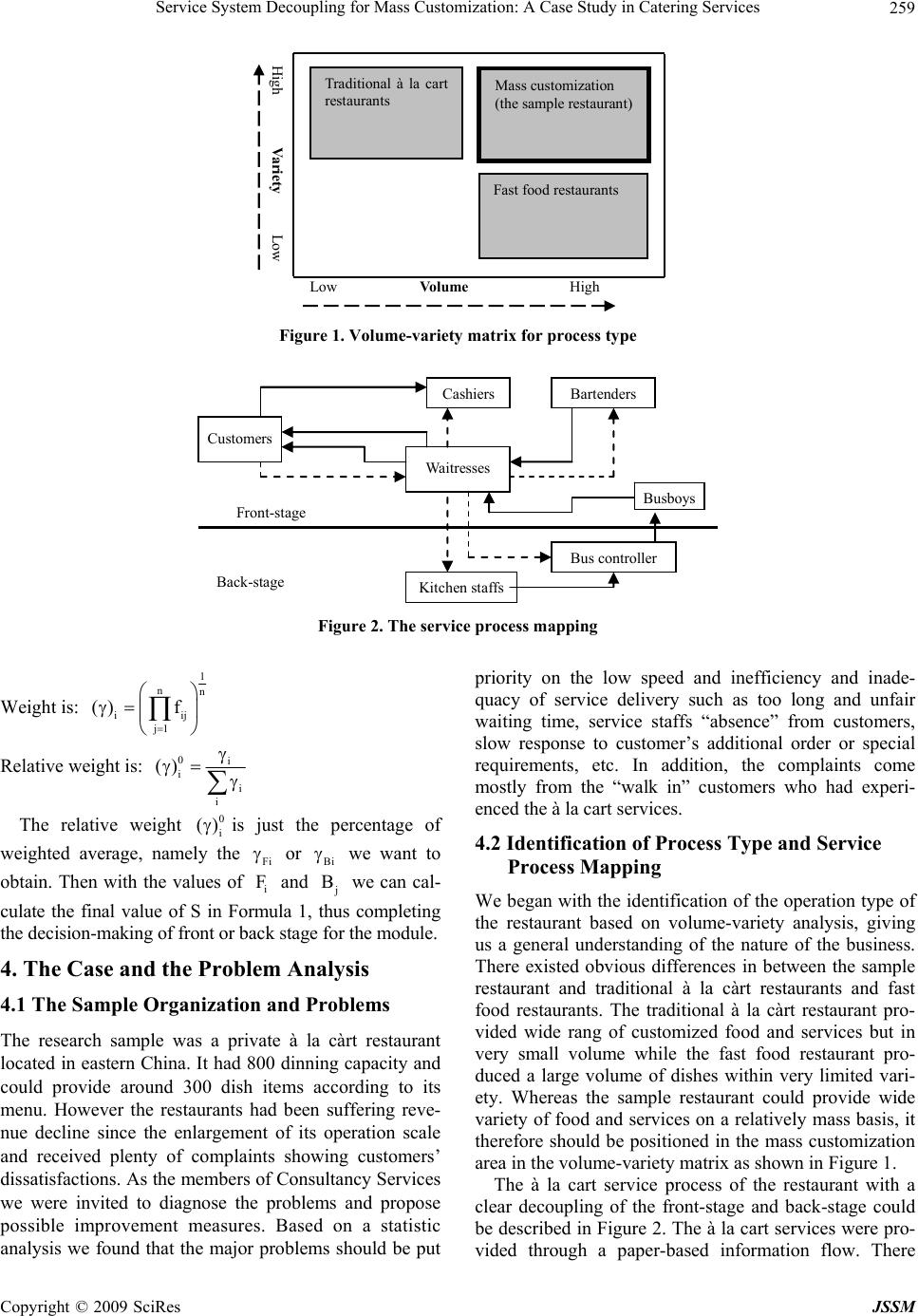 Service System Decoupling for Mass Customization: A Case Study in Catering Services259 Mass customization (the sample restaurant) Volume High Variety High Traditional à la cart restaurants Fast food restaurants Low Low Figure 1. Volume-variety matrix for process type Kitchen staffs Back-stage Busboys Cashiers Bus controller Front-stage Customers Waitresses Bartenders Figure 2. The service process mapping Weight is: 1 nn ii j1 () f j Relative weight is: 0i i i i () The relative weight 0 i () is just the percentage of weighted average, namely the Fi or Bi we want to obtain. Then with the values of and we can cal- culate the final value of S in Formula 1, thus completing the decision-making of front or back stage for the module. i Fj B 4. The Case and the Problem Analysis 4.1 The Sample Organization and Problems The research sample was a private à la càrt restaurant located in eastern China. It had 800 dinning capacity and could provide around 300 dish items according to its menu. However the restaurants had been suffering reve- nue decline since the enlargement of its operation scale and received plenty of complaints showing customers’ dissatisfactions. As the members of Consultancy Services we were invited to diagnose the problems and propose possible improvement measures. Based on a statistic analysis we found that the major problems should be put priority on the low speed and inefficiency and inade- quacy of service delivery such as too long and unfair waiting time, service staffs “absence” from customers, slow response to customer’s additional order or special requirements, etc. In addition, the complaints come mostly from the “walk in” customers who had experi- enced the à la cart services. 4.2 Identification of Process Type and Service Process Mapping We began with the identification of the operation type of the restaurant based on volume-variety analysis, giving us a general understanding of the nature of the business. There existed obvious differences in between the sample restaurant and traditional à la càrt restaurants and fast food restaurants. The traditional à la càrt restaurant pro- vided wide rang of customized food and services but in very small volume while the fast food restaurant pro- duced a large volume of dishes within very limited vari- ety. Whereas the sample restaurant could provide wide variety of food and services on a relatively mass basis, it therefore should be positioned in the mass customization area in the volume-variety matrix as shown in Figure 1. The à la cart service process of the restaurant with a clear decoupling of the front-stage and back-stage could be described in Figure 2. The à la cart services were pro- vided through a paper-based information flow. There Copyright © 2009 SciRes JSSM 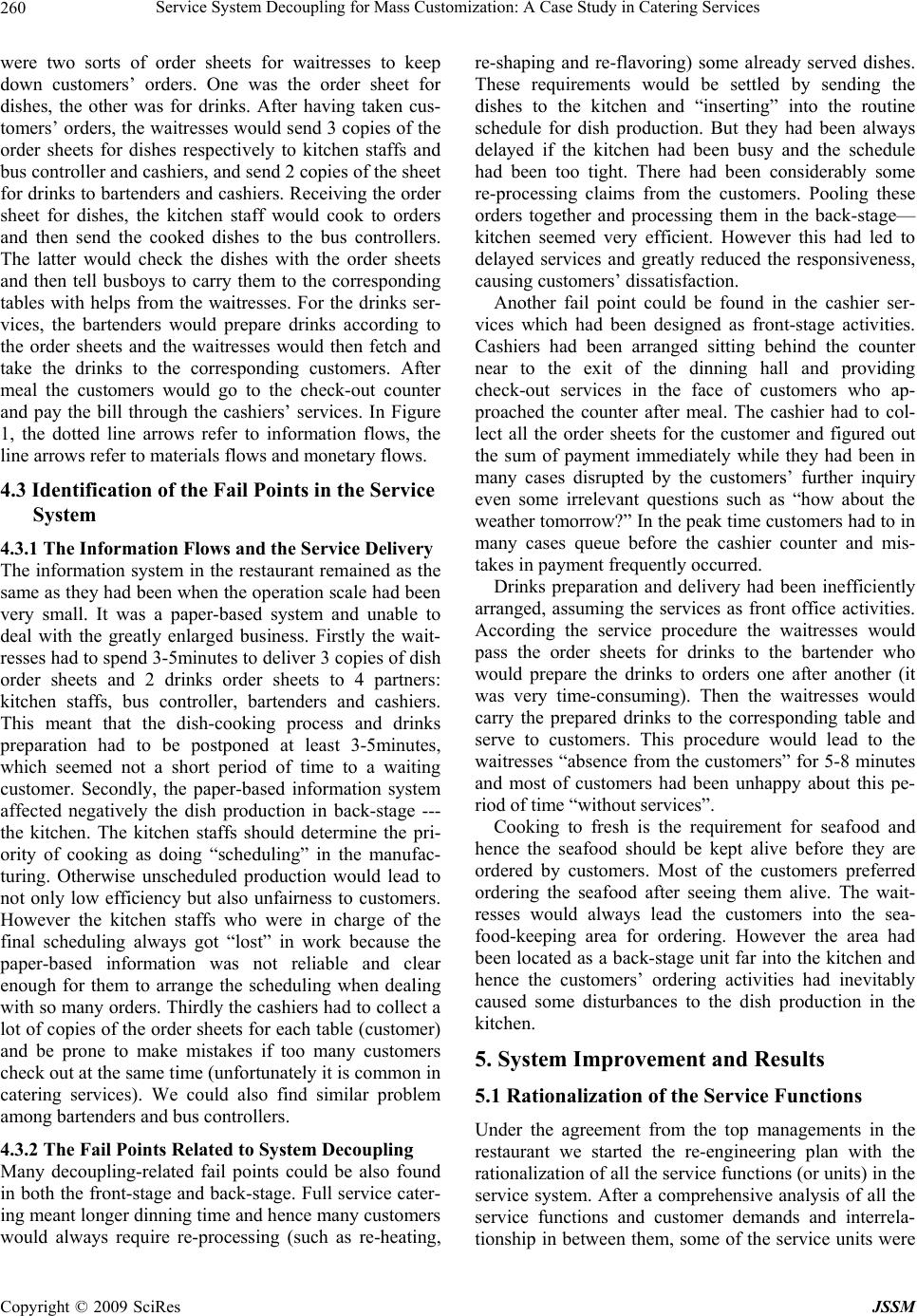 Service System Decoupling for Mass Customization: A Case Study in Catering Services 260 were two sorts of order sheets for waitresses to keep down customers’ orders. One was the order sheet for dishes, the other was for drinks. After having taken cus- tomers’ orders, the waitresses would send 3 copies of the order sheets for dishes respectively to kitchen staffs and bus controller and cashiers, and send 2 copies of the sheet for drinks to bartenders and cashiers. Receiving the order sheet for dishes, the kitchen staff would cook to orders and then send the cooked dishes to the bus controllers. The latter would check the dishes with the order sheets and then tell busboys to carry them to the corresponding tables with helps from the waitresses. For the drinks ser- vices, the bartenders would prepare drinks according to the order sheets and the waitresses would then fetch and take the drinks to the corresponding customers. After meal the customers would go to the check-out counter and pay the bill through the cashiers’ services. In Figure 1, the dotted line arrows refer to information flows, the line arrows refer to materials flows and monetary flows. 4.3 Identification of the Fail Points in the Service System 4.3.1 The Information Flows and the Service Delivery The information system in the restaurant remained as the same as they had been when the operation scale had been very small. It was a paper-based system and unable to deal with the greatly enlarged business. Firstly the wait- resses had to spend 3-5minutes to deliver 3 copies of dish order sheets and 2 drinks order sheets to 4 partners: kitchen staffs, bus controller, bartenders and cashiers. This meant that the dish-cooking process and drinks preparation had to be postponed at least 3-5minutes, which seemed not a short period of time to a waiting customer. Secondly, the paper-based information system affected negatively the dish production in back-stage --- the kitchen. The kitchen staffs should determine the pri- ority of cooking as doing “scheduling” in the manufac- turing. Otherwise unscheduled production would lead to not only low efficiency but also unfairness to customers. However the kitchen staffs who were in charge of the final scheduling always got “lost” in work because the paper-based information was not reliable and clear enough for them to arrange the scheduling when dealing with so many orders. Thirdly the cashiers had to collect a lot of copies of the order sheets for each table (customer) and be prone to make mistakes if too many customers check out at the same time (unfortunately it is common in catering services). We could also find similar problem among bartenders and bus controllers. 4.3.2 The Fail Points Related to System Decoupling Many decoupling-related fail points could be also found in both the front-stage and back-stage. Full service cater- ing meant longer dinning time and hence many customers would always require re-processing (such as re-heating, re-shaping and re-flavoring) some already served dishes. These requirements would be settled by sending the dishes to the kitchen and “inserting” into the routine schedule for dish production. But they had been always delayed if the kitchen had been busy and the schedule had been too tight. There had been considerably some re-processing claims from the customers. Pooling these orders together and processing them in the back-stage— kitchen seemed very efficient. However this had led to delayed services and greatly reduced the responsiveness, causing customers’ dissatisfaction. Another fail point could be found in the cashier ser- vices which had been designed as front-stage activities. Cashiers had been arranged sitting behind the counter near to the exit of the dinning hall and providing check-out services in the face of customers who ap- proached the counter after meal. The cashier had to col- lect all the order sheets for the customer and figured out the sum of payment immediately while they had been in many cases disrupted by the customers’ further inquiry even some irrelevant questions such as “how about the weather tomorrow?” In the peak time customers had to in many cases queue before the cashier counter and mis- takes in payment frequently occurred. Drinks preparation and delivery had been inefficiently arranged, assuming the services as front office activities. According the service procedure the waitresses would pass the order sheets for drinks to the bartender who would prepare the drinks to orders one after another (it was very time-consuming). Then the waitresses would carry the prepared drinks to the corresponding table and serve to customers. This procedure would lead to the waitresses “absence from the customers” for 5-8 minutes and most of customers had been unhappy about this pe- riod of time “without services”. Cooking to fresh is the requirement for seafood and hence the seafood should be kept alive before they are ordered by customers. Most of the customers preferred ordering the seafood after seeing them alive. The wait- resses would always lead the customers into the sea- food-keeping area for ordering. However the area had been located as a back-stage unit far into the kitchen and hence the customers’ ordering activities had inevitably caused some disturbances to the dish production in the kitchen. 5. System Improvement and Results 5.1 Rationalization of the Service Functions Under the agreement from the top managements in the restaurant we started the re-engineering plan with the rationalization of all the service functions (or units) in the service system. After a comprehensive analysis of all the service functions and customer demands and interrela- tionship in between them, some of the service units were Copyright © 2009 SciRes JSSM 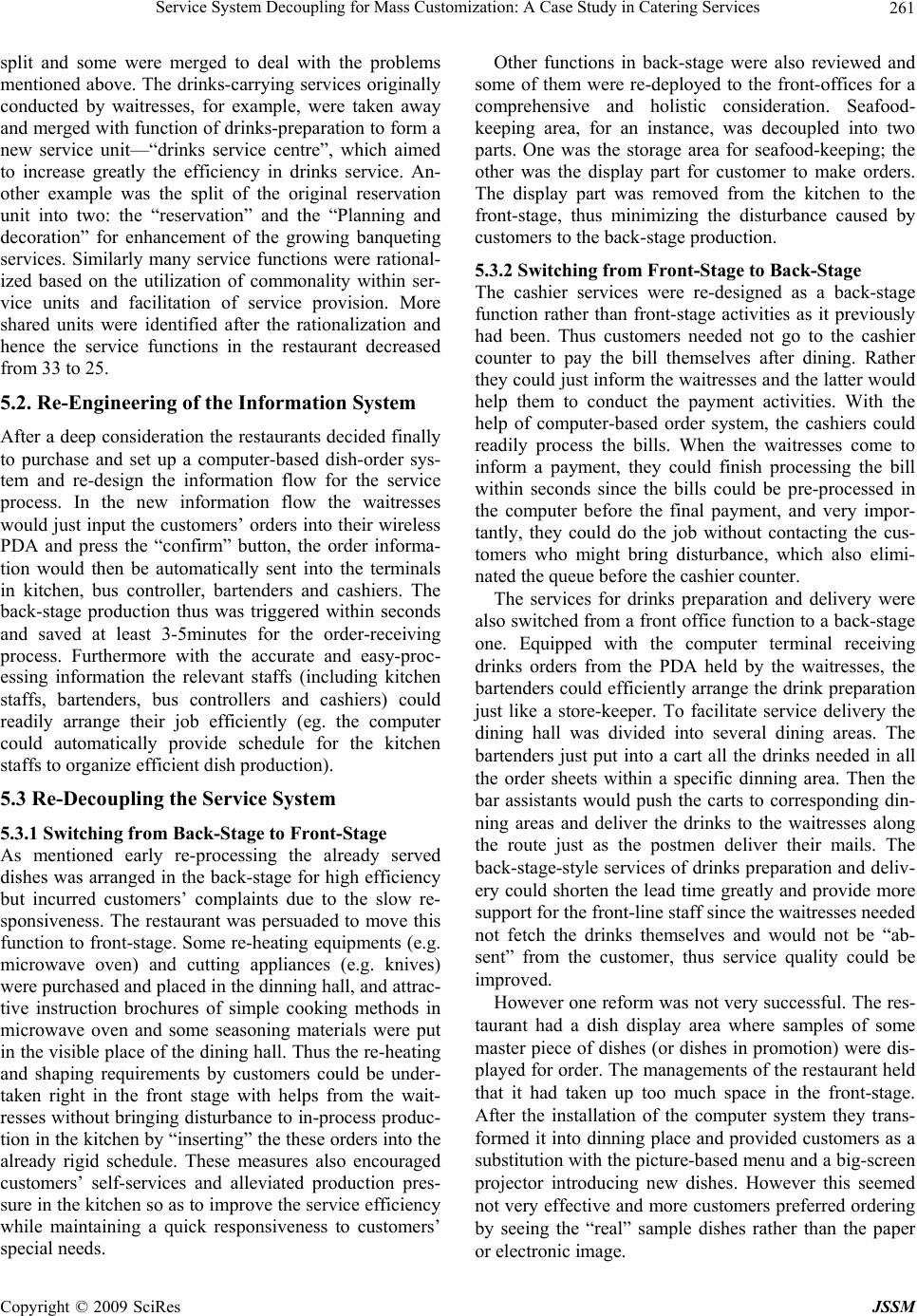 Service System Decoupling for Mass Customization: A Case Study in Catering Services261 split and some were merged to deal with the problems mentioned above. The drinks-carrying services originally conducted by waitresses, for example, were taken away and merged with function of drinks-preparation to form a new service unit—“drinks service centre”, which aimed to increase greatly the efficiency in drinks service. An- other example was the split of the original reservation unit into two: the “reservation” and the “Planning and decoration” for enhancement of the growing banqueting services. Similarly many service functions were rational- ized based on the utilization of commonality within ser- vice units and facilitation of service provision. More shared units were identified after the rationalization and hence the service functions in the restaurant decreased from 33 to 25. 5.2. Re-Engineering of the Information System After a deep consideration the restaurants decided finally to purchase and set up a computer-based dish-order sys- tem and re-design the information flow for the service process. In the new information flow the waitresses would just input the customers’ orders into their wireless PDA and press the “confirm” button, the order informa- tion would then be automatically sent into the terminals in kitchen, bus controller, bartenders and cashiers. The back-stage production thus was triggered within seconds and saved at least 3-5minutes for the order-receiving process. Furthermore with the accurate and easy-proc- essing information the relevant staffs (including kitchen staffs, bartenders, bus controllers and cashiers) could readily arrange their job efficiently (eg. the computer could automatically provide schedule for the kitchen staffs to organize efficient dish production). 5.3 Re-Decoupling the Service System 5.3.1 Switching from Back-Stage to Front-Stage As mentioned early re-processing the already served dishes was arranged in the back-stage for high efficiency but incurred customers’ complaints due to the slow re- sponsiveness. The restaurant was persuaded to move this function to front-stage. Some re-heating equipments (e.g. microwave oven) and cutting appliances (e.g. knives) were purchased and placed in the dinning hall, and attrac- tive instruction brochures of simple cooking methods in microwave oven and some seasoning materials were put in the visible place of the dining hall. Thus the re-heating and shaping requirements by customers could be under- taken right in the front stage with helps from the wait- resses without bringing disturbance to in-process produc- tion in the kitchen by “inserting” the these orders into the already rigid schedule. These measures also encouraged customers’ self-services and alleviated production pres- sure in the kitchen so as to improve the service efficiency while maintaining a quick responsiveness to customers’ special needs. Other functions in back-stage were also reviewed and some of them were re-deployed to the front-offices for a comprehensive and holistic consideration. Seafood- keeping area, for an instance, was decoupled into two parts. One was the storage area for seafood-keeping; the other was the display part for customer to make orders. The display part was removed from the kitchen to the front-stage, thus minimizing the disturbance caused by customers to the back-stage production. 5.3.2 Switching from Front-Stage to Back-Stage The cashier services were re-designed as a back-stage function rather than front-stage activities as it previously had been. Thus customers needed not go to the cashier counter to pay the bill themselves after dining. Rather they could just inform the waitresses and the latter would help them to conduct the payment activities. With the help of computer-based order system, the cashiers could readily process the bills. When the waitresses come to inform a payment, they could finish processing the bill within seconds since the bills could be pre-processed in the computer before the final payment, and very impor- tantly, they could do the job without contacting the cus- tomers who might bring disturbance, which also elimi- nated the queue before the cashier counter. The services for drinks preparation and delivery were also switched from a front office function to a back-stage one. Equipped with the computer terminal receiving drinks orders from the PDA held by the waitresses, the bartenders could efficiently arrange the drink preparation just like a store-keeper. To facilitate service delivery the dining hall was divided into several dining areas. The bartenders just put into a cart all the drinks needed in all the order sheets within a specific dinning area. Then the bar assistants would push the carts to corresponding din- ning areas and deliver the drinks to the waitresses along the route just as the postmen deliver their mails. The back-stage-style services of drinks preparation and deliv- ery could shorten the lead time greatly and provide more support for the front-line staff since the waitresses needed not fetch the drinks themselves and would not be “ab- sent” from the customer, thus service quality could be improved. However one reform was not very successful. The res- taurant had a dish display area where samples of some master piece of dishes (or dishes in promotion) were dis- played for order. The managements of the restaurant held that it had taken up too much space in the front-stage. After the installation of the computer system they trans- formed it into dinning place and provided customers as a substitution with the picture-based menu and a big-screen projector introducing new dishes. However this seemed not very effective and more customers preferred ordering by seeing the “real” sample dishes rather than the paper or electronic image. Copyright © 2009 SciRes JSSM 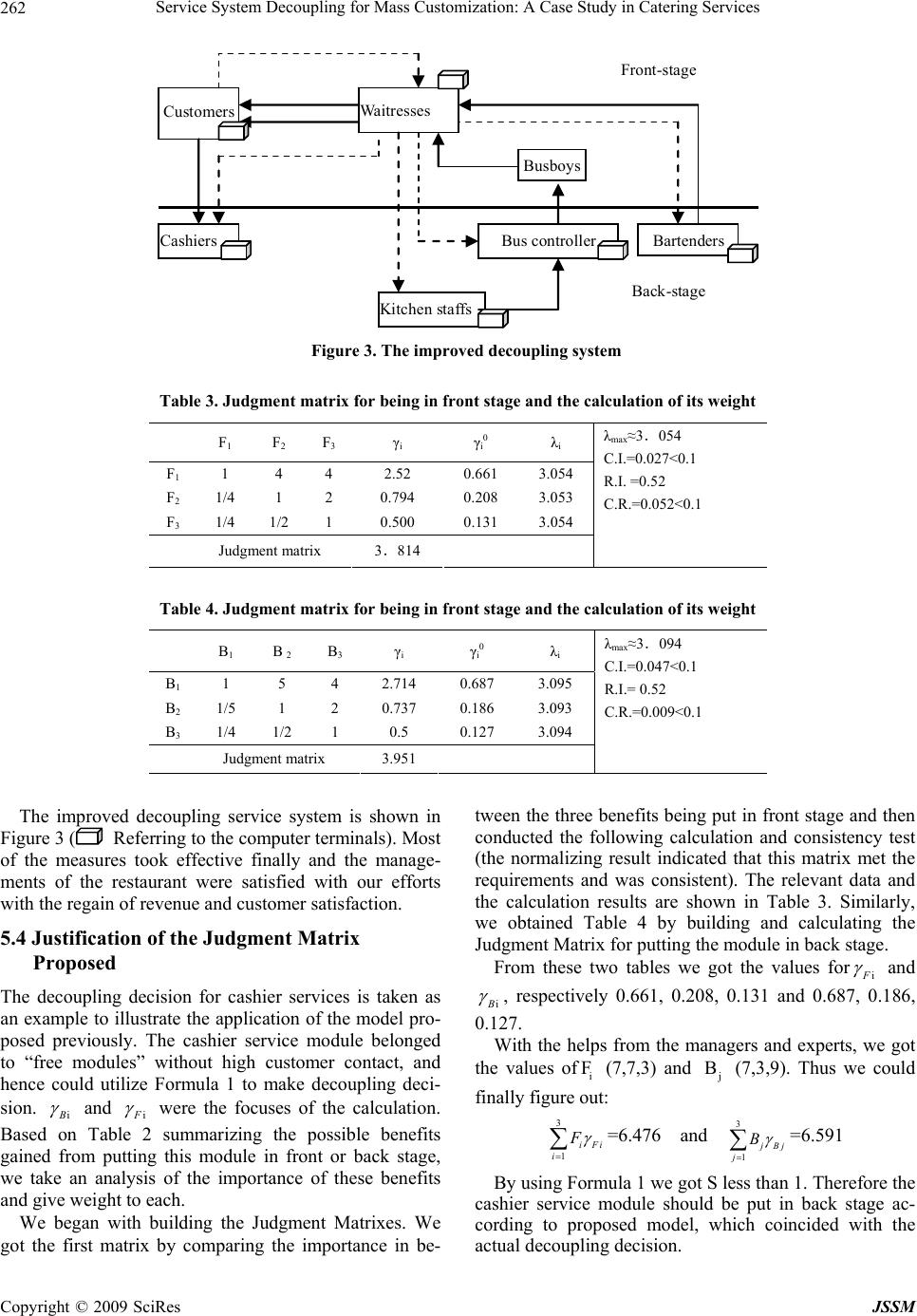 Service System Decoupling for Mass Customization: A Case Study in Catering Services Copyright © 2009 SciRes JSSM 262 Kitchen staffs Back-stage Busboys Cashiers Bus controller Front-stage Customers Waitresses Bartenders Figure 3. The improved decoupling system Table 3. Judgment matrix for being in front stage and the calculation of its weight F1 F 2 F 3 γi γi0 λi F1 1 4 4 2.52 0.661 3.054 F2 1/4 1 2 0.794 0.208 3.053 F3 1/4 1/2 1 0.500 0.131 3.054 3.814 λmax≈3.054 C.I.=0.027<0.1 R.I. =0.52 C.R.=0.052<0.1 Judgment matrix Table 4. Judgment matrix for being in front stage and the calculation of its weight B1 B 2 B 3 γi γi0 λi B1 1 5 4 2.714 0.687 3.095 B2 1/5 1 2 0.737 0.186 3.093 B3 1/4 1/2 1 0.5 0.127 3.094 3.951 λmax≈3.094 C.I.=0.047<0.1 R.I.= 0.52 C.R.=0.009<0.1 Judgment matrix tween the three benefits being put in front stage and then conducted the following calculation and consistency test (the normalizing result indicated that this matrix met the requirements and was consistent). The relevant data and the calculation results are shown in Table 3. Similarly, we obtained Table 4 by building and calculating the Judgment Matrix for putting the module in back stage. The improved decoupling service system is shown in Figure 3 ( Referring to the computer terminals). Most of the measures took effective finally and the manage- ments of the restaurant were satisfied with our efforts with the regain of revenue and customer satisfaction. 5.4 Justification of the Judgment Matrix Proposed From these two tables we got the values fori F and i B , respectively 0.661, 0.208, 0.131 and 0.687, 0.186, 0.127. The decoupling decision for cashier services is taken as an example to illustrate the application of the model pro- posed previously. The cashier service module belonged to “free modules” without high customer contact, and hence could utilize Formula 1 to make decoupling deci- sion. i B and i F were the focuses of the calculation. Based on Table 2 summarizing the possible benefits gained from putting this module in front or back stage, we take an analysis of the importance of these benefits and give weight to each. With the helps from the managers and experts, we got the values of (7,7,3) and (7,3,9). Thus we could finally figure out: i Fj B 3 1 iFi i F =6.476 and 3 1 jBj j B =6.591 By using Formula 1 we got S less than 1. Therefore the cashier service module should be put in back stage ac- cording to proposed model, which coincided with the actual decoupling decision. We began with building the Judgment Matrixes. We got the first matrix by comparing the importance in be- 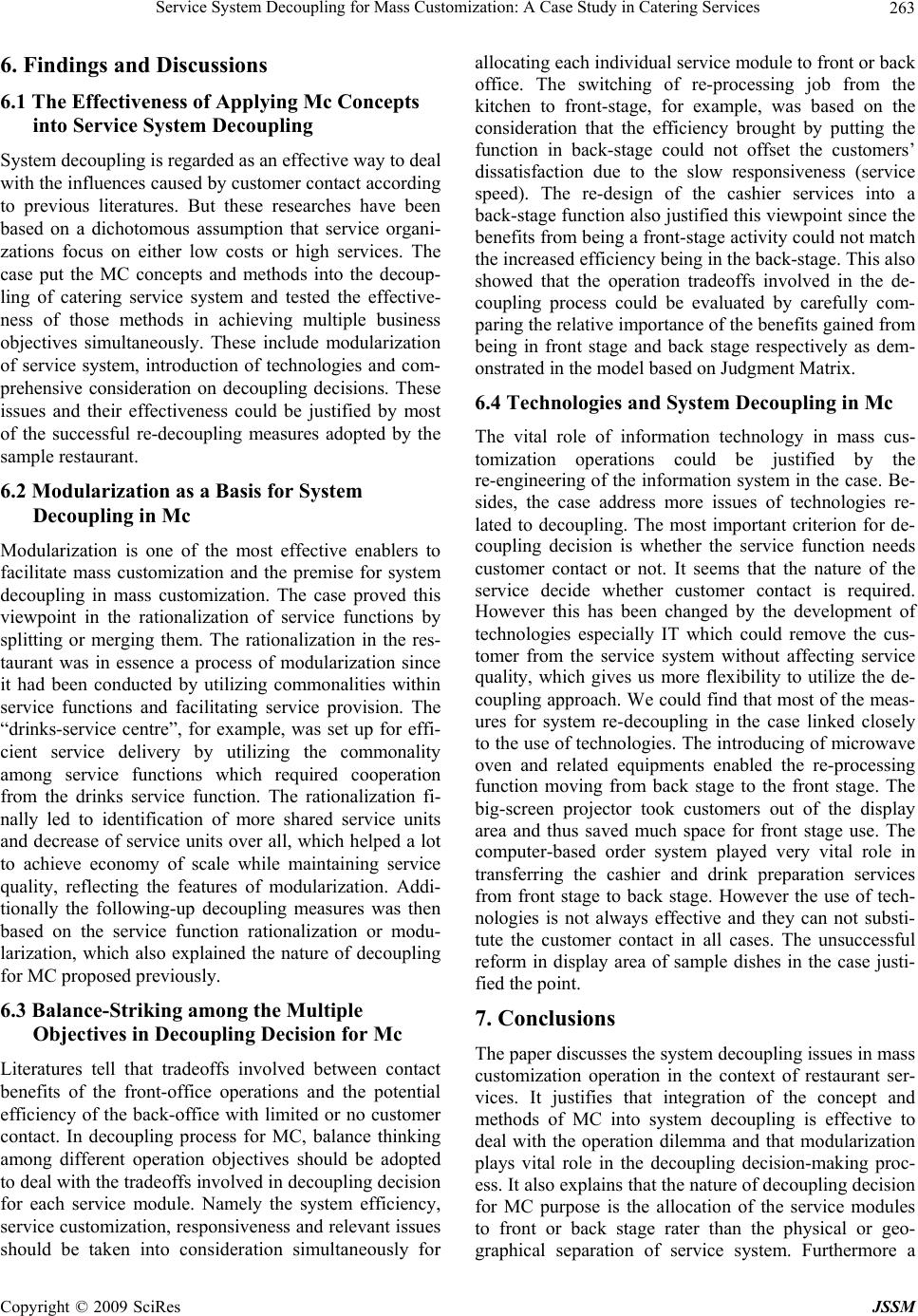 Service System Decoupling for Mass Customization: A Case Study in Catering Services263 6. Findings and Discussions 6.1 The Effectiveness of Applying Mc Concepts into Service System Decoupling System decoupling is regarded as an effective way to deal with the influences caused by customer contact according to previous literatures. But these researches have been based on a dichotomous assumption that service organi- zations focus on either low costs or high services. The case put the MC concepts and methods into the decoup- ling of catering service system and tested the effective- ness of those methods in achieving multiple business objectives simultaneously. These include modularization of service system, introduction of technologies and com- prehensive consideration on decoupling decisions. These issues and their effectiveness could be justified by most of the successful re-decoupling measures adopted by the sample restaurant. 6.2 Modularization as a Basis for System Decoupling in Mc Modularization is one of the most effective enablers to facilitate mass customization and the premise for system decoupling in mass customization. The case proved this viewpoint in the rationalization of service functions by splitting or merging them. The rationalization in the res- taurant was in essence a process of modularization since it had been conducted by utilizing commonalities within service functions and facilitating service provision. The “drinks-service centre”, for example, was set up for effi- cient service delivery by utilizing the commonality among service functions which required cooperation from the drinks service function. The rationalization fi- nally led to identification of more shared service units and decrease of service units over all, which helped a lot to achieve economy of scale while maintaining service quality, reflecting the features of modularization. Addi- tionally the following-up decoupling measures was then based on the service function rationalization or modu- larization, which also explained the nature of decoupling for MC proposed previously. 6.3 Balance-Striking among the Multiple Objectives in Decoupling Decision for Mc Literatures tell that tradeoffs involved between contact benefits of the front-office operations and the potential efficiency of the back-office with limited or no customer contact. In decoupling process for MC, balance thinking among different operation objectives should be adopted to deal with the tradeoffs involved in decoupling decision for each service module. Namely the system efficiency, service customization, responsiveness and relevant issues should be taken into consideration simultaneously for allocating each individual service module to front or back office. The switching of re-processing job from the kitchen to front-stage, for example, was based on the consideration that the efficiency brought by putting the function in back-stage could not offset the customers’ dissatisfaction due to the slow responsiveness (service speed). The re-design of the cashier services into a back-stage function also justified this viewpoint since the benefits from being a front-stage activity could not match the increased efficiency being in the back-stage. This also showed that the operation tradeoffs involved in the de- coupling process could be evaluated by carefully com- paring the relative importance of the benefits gained from being in front stage and back stage respectively as dem- onstrated in the model based on Judgment Matrix. 6.4 Technologies and System Decoupling in Mc The vital role of information technology in mass cus- tomization operations could be justified by the re-engineering of the information system in the case. Be- sides, the case address more issues of technologies re- lated to decoupling. The most important criterion for de- coupling decision is whether the service function needs customer contact or not. It seems that the nature of the service decide whether customer contact is required. However this has been changed by the development of technologies especially IT which could remove the cus- tomer from the service system without affecting service quality, which gives us more flexibility to utilize the de- coupling approach. We could find that most of the meas- ures for system re-decoupling in the case linked closely to the use of technologies. The introducing of microwave oven and related equipments enabled the re-processing function moving from back stage to the front stage. The big-screen projector took customers out of the display area and thus saved much space for front stage use. The computer-based order system played very vital role in transferring the cashier and drink preparation services from front stage to back stage. However the use of tech- nologies is not always effective and they can not substi- tute the customer contact in all cases. The unsuccessful reform in display area of sample dishes in the case justi- fied the point. 7. Conclusions The paper discusses the system decoupling issues in mass customization operation in the context of restaurant ser- vices. It justifies that integration of the concept and methods of MC into system decoupling is effective to deal with the operation dilemma and that modularization plays vital role in the decoupling decision-making proc- ess. It also explains that the nature of decoupling decision for MC purpose is the allocation of the service modules to front or back stage rater than the physical or geo- graphical separation of service system. Furthermore a Copyright © 2009 SciRes JSSM 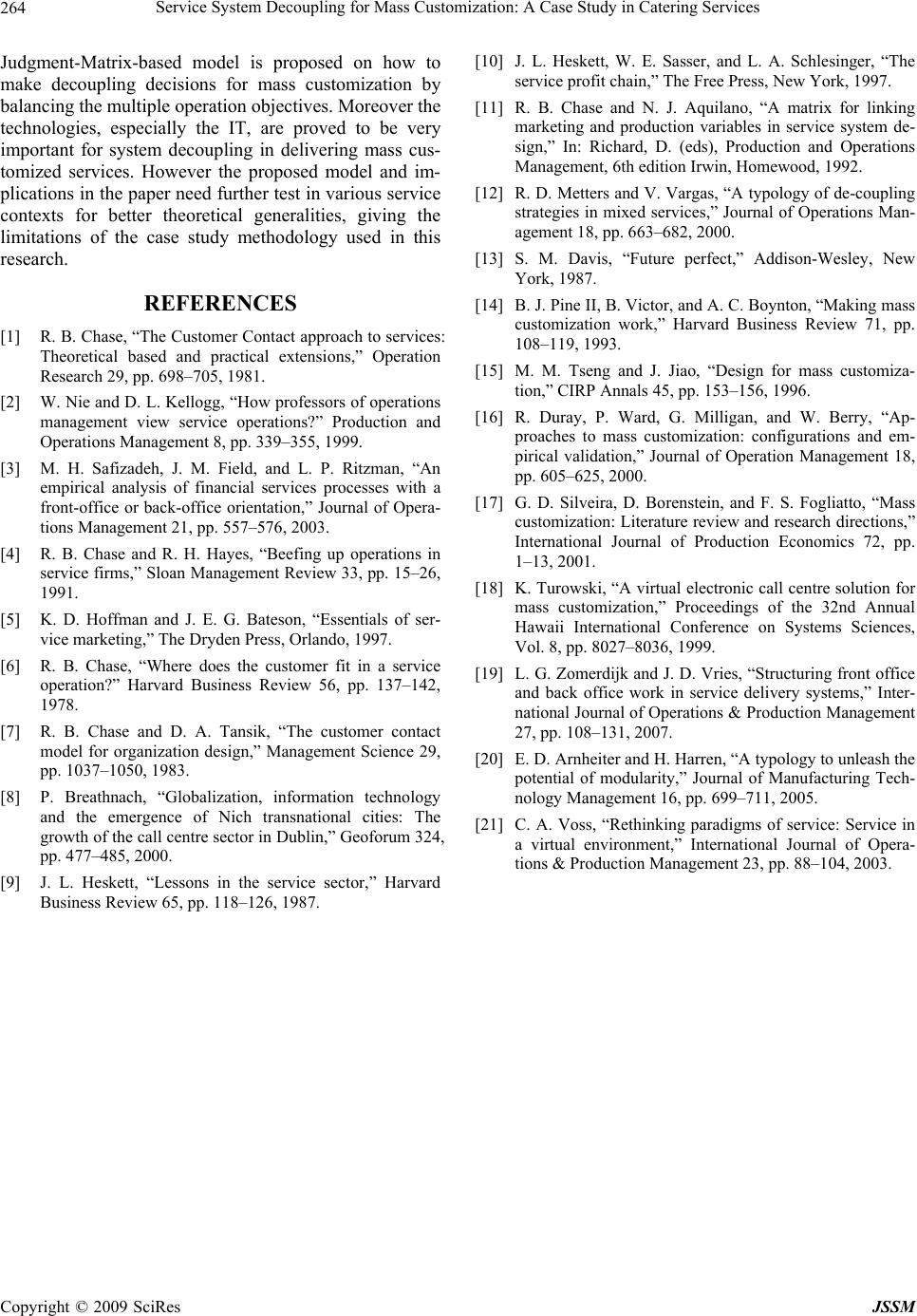 Service System Decoupling for Mass Customization: A Case Study in Catering Services Copyright © 2009 SciRes JSSM 264 Judgment-Matrix-based model is proposed on how to make decoupling decisions for mass customization by balancing the multiple operation objectives. Moreover the technologies, especially the IT, are proved to be very important for system decoupling in delivering mass cus- tomized services. However the proposed model and im- plications in the paper need further test in various service contexts for better theoretical generalities, giving the limitations of the case study methodology used in this research. REFERENCES [1] R. B. Chase, “The Customer Contact approach to services: Theoretical based and practical extensions,” Operation Research 29, pp. 698–705, 1981. [2] W. Nie and D. L. Kellogg, “How professors of operations management view service operations?” Production and Operations Management 8, pp. 339–355, 1999. [3] M. H. Safizadeh, J. M. Field, and L. P. Ritzman, “An empirical analysis of financial services processes with a front-office or back-office orientation,” Journal of Opera- tions Management 21, pp. 557–576, 2003. [4] R. B. Chase and R. H. Hayes, “Beefing up operations in service firms,” Sloan Management Review 33, pp. 15–26, 1991. [5] K. D. Hoffman and J. E. G. Bateson, “Essentials of ser- vice marketing,” The Dryden Press, Orlando, 1997. [6] R. B. Chase, “Where does the customer fit in a service operation?” Harvard Business Review 56, pp. 137–142, 1978. [7] R. B. Chase and D. A. Tansik, “The customer contact model for organization design,” Management Science 29, pp. 1037–1050, 1983. [8] P. Breathnach, “Globalization, information technology and the emergence of Nich transnational cities: The growth of the call centre sector in Dublin,” Geoforum 324, pp. 477–485, 2000. [9] J. L. Heskett, “Lessons in the service sector,” Harvard Business Review 65, pp. 118–126, 1987. [10] J. L. Heskett, W. E. Sasser, and L. A. Schlesinger, “The service profit chain,” The Free Press, New York, 1997. [11] R. B. Chase and N. J. Aquilano, “A matrix for linking marketing and production variables in service system de- sign,” In: Richard, D. (eds), Production and Operations Management, 6th edition Irwin, Homewood, 1992. [12] R. D. Metters and V. Vargas, “A typology of de-coupling strategies in mixed services,” Journal of Operations Man- agement 18, pp. 663–682, 2000. [13] S. M. Davis, “Future perfect,” Addison-Wesley, New York, 1987. [14] B. J. Pine II, B. Victor, and A. C. Boynton, “Making mass customization work,” Harvard Business Review 71, pp. 108–119, 1993. [15] M. M. Tseng and J. Jiao, “Design for mass customiza- tion,” CIRP Annals 45, pp. 153–156, 1996. [16] R. Duray, P. Ward, G. Milligan, and W. Berry, “Ap- proaches to mass customization: configurations and em- pirical validation,” Journal of Operation Management 18, pp. 605–625, 2000. [17] G. D. Silveira, D. Borenstein, and F. S. Fogliatto, “Mass customization: Literature review and research directions,” International Journal of Production Economics 72, pp. 1–13, 2001. [18] K. Turowski, “A virtual electronic call centre solution for mass customization,” Proceedings of the 32nd Annual Hawaii International Conference on Systems Sciences, Vol. 8, pp. 8027–8036, 1999. [19] L. G. Zomerdijk and J. D. Vries, “Structuring front office and back office work in service delivery systems,” Inter- national Journal of Operations & Production Management 27, pp. 108–131, 2007. [20] E. D. Arnheiter and H. Harren, “A typology to unleash the potential of modularity,” Journal of Manufacturing Tech- nology Management 16, pp. 699–711, 2005. [21] C. A. Voss, “Rethinking paradigms of service: Service in a virtual environment,” International Journal of Opera- tions & Production Management 23, pp. 88–104, 2003. |

